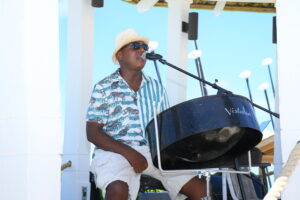News
Turks and Caicos, the delicate balance between development and preservation
Published
2 years agoon

#TurksandCaicos, November 11, 2023 – Like myself, some citizens are often skeptical about any major developments and rapid population growth across these islands. It is seen as a danger in commoditising deeply held traditions so closely linked to individuals and our collective identity.
But there is a caveat, many still see it as the primary way to keep these tiny islands alive and to survive.
Tourism is the bread and butter of this tiny British overseas territory, with close to 800 million US dollars annually. This alone corresponds to approximately 75% of the country’s gross domestic product. Although Providenciales is the main hub for visitors via air travel, many are unaware that the sister islands are only a hop, skip and a jump away either by an interconnecting flight or the local ferry boats.
This alone corresponds to approximately 75% of the country’s gross domestic product. Although Providenciales is the main hub for visitors via air travel, many are unaware that the sister islands are only a hop, skip and a jump away either by an interconnecting flight or the local ferry boats.
In recent years, visitors are flocking to the historical island of Grand Turk which is the capital of the Turks and Caicos Islands. Although, in terms of development, it may not appear to be.
On this island in particular, over 80 percent of the residents depend to some extent on tourism. Grand Turk has a number of the amenities as most major cities, but still gives you that small town feel.
Like the sister island, Salt Cay, some supplies are limited. There is a fairly large selection of groceries at the supermarkets, however, healthy foods come at a high price. What residents and visitors can depend on is fresh catch of the day, which is regularly available by the local fishermen at reasonable prices.
Those in the tourism business tend to try and earn as much of their income as possible from visitors during the peak tourism season which is between November and April.
Many of the locals are still passionate with keeping the culture alive, and aren’t just motivated by cash for cash own sake, or the US dollar which is the only currency used. Nevertheless, tourism money is most definitely needed to improve infrastructure and quality of life on practically all of these islands.
Apart from the transient visitors and on cruise ship days, the population on Grand Turk is roughly around 3500 residents. Over the years, it has slowly dwindled once major development on the island of Providenciales began to take shape.
The nature of island life especially on Grand Turk and Salt Cay, has satisfactory temperamental transportation, and with a bit of pre-planning, a trip to any one of these islands is plenty rewarding for those looking for a charming, quiet atmosphere, beautiful by nature beaches, and a unique culture.
The nightlife in Grand Turk is pretty quiet and may be a bit different from what some are used too. With some exceptions, there are a few small neighborhood bars where you can mingle with the locals or enjoy a good laugh or play a few games of dominoes.
Grand Turk is the home of one of the oldest lighthouses in the Caribbean. For lighthouse enthusiast, although entrance into the building itself is off limit, one will enjoy the breathtaking scenery and will find it both charming and fascinating.
If you’re like most tourists looking for fancy hotels, five course meals, or seeking a choice of watching a night show, these things are not the norm.
Come if you’re interested in this spectacular island laidback culture, where you are still greeted with big smiles, good morning, or good evening, waving hands, honking horns and most everyone knows you by your last name.
For many reasons, my favorite island still remains Grand Turk. It’s captures the essence of the Turks and Caicos Islands culture, with a shared sense of identity. This is where I graduated high school and made most of my early childhood memories. One of the few islands in the Caribbean where cows, horses, donkeys and friendly dogs still roam wild.
Among the many ecotourism and land activities, one can enjoy things like snorkeling, stingray encounters, fishing, ATV and horseback rides.
If your lucky, during peak season, you may get a glimpse of the humpback whales breaching right from the shoreline or pier, which is a niche market to Grand Turk and Salt Cay.
Most people come just to be in the middle of nature and have that small island feeling. An opportunity to bask in the sunshine, the tranquility, enjoy the secluded beaches and stretches of unspoiled coastlines.
What the islands are experiencing now is an influx of vacationers on their second or third time around. Many who have found lucrative business opportunities and are investing in vacation homes and Air BNB rentals.
When you’re on the island, you take it for granted that life is like that; you don’t see the value in living that hustle and bustle lifestyle elsewhere. If you’re lucky to arrive on cruise ship days to Grand Turk, you can enjoy some entertainment and food for a few hours before returning to the quiet lifestyle.
Many visitors are usually fascinated with the laidback culture, relatively low crime rate and friendly people.
In my opinion, the island itself will benefit more if greater focus is placed on developing our unique culture as one of the main attractions which tourists enjoy. This could also help to support the community’s ability to keep those traditions alive and thriving.
On the other hand, unchecked growth may have negative downstream consequences.
The rapid growth on the island of Providenciales is a good example of that. Grand Turk in particular has less than 5 commercial motels for tourists to stay, while the island of Providenciales is booming in this sector.
What we are beginning to see are more short term rentals and Air B&B-style accommodations. Albeit, I think having at least one major hotel in Grand Turk and a direct flight would be welcomed by many.
Nevertheless, more development could compromise both the community and the environment, swinging the Capital out of its current beautiful by nature precarious equilibrium.
Furthermore, with having limited real estate on this tiny island, finding that balance is crucial for the government. It could help to protect residents from predatory land grab and prevent them from being priced out of their homes.
Perhaps, it would be prudent to invest and capitalize on some of our existing natural resources and historical sites.
In short order, starting with the restoration of our eighteen century light house, the old prison, our Salt house or more vigorously promoting the “magnificant wall”. The Wall as it is referred to, is an amazing 7k feet deep ocean shelf, approximately 1000 feet off Grand Turk shore line, a dream for snorkelers and scuba diving enthusiasts.
To attract repeat visitors, so much more can be done, while limiting the proliferation of brick and mortar buildings. The million dollar question now is how much development do we want? Despite the rustic look, the inconvenience at times, the occasional mosquitoes, the lack of adequate resources in some areas, its still a hidden gem.
For those having duel citizenship and easy access to travel visas, being able to go back and forward to the United States and elsewhere as one desires, it’s priceless! This is truly having the best of both worlds.
Cheers!
Ed Forbes
You may like
News
Beaches Turks and Caicos Showcases and Supports Local Creativity
Published
3 months agoon
September 12, 2025
September 12, 2025
PROVIDENCIALES, Turks & Caicos Islands – The Turks and Caicos Islands are home to a wealth of creativity, from artisans and craft vendors to musicians and performers. Beaches Turks and Caicos, the Caribbean’s leading all-inclusive family resort, has pledged its continued support for these individuals by providing meaningful platforms for them to share their skills and stories with guests from around the world.
The resort’s commitment is most evident in its weekly Cultural Night showcase, where visitors are immersed in the vibrant traditions of the islands. Guests enjoy live performances which feature local music genres such as ripsaw, while artisans display and sell handmade creations. This event not only enriches the guest experience but also strengthens economic opportunities for local entrepreneurs.
Entertainment Division Manager Garett Bailey emphasized the significance of Cultural Night, “we want to showcase everything the Turks and Caicos Islands culture has to offer. Our goal is for guests to leave with a deeper appreciation of the island’s art, music and traditions, while giving local talent the opportunity to share their creativity with visitors from across the globe.”
Beyond Cultural Night, Beaches Turks and Caicos also welcomes local craft vendors onto the resort every Wednesday and Friday where they are offered a direct space to market their goods. Guests have easy access to the Turks and Caicos Cultural Marketplace, where they can purchase authentic local arts and crafts.
where they are offered a direct space to market their goods. Guests have easy access to the Turks and Caicos Cultural Marketplace, where they can purchase authentic local arts and crafts.
Managing Director, James McAnally, highlighted how these initiatives reflect the resort’s broader mission, “we are committed to celebrating and sharing the vibrant culture of these islands with our guests. By showcasing local artistry and music, we not only provide entertainment but also help sustain and grow the creative industries of the Turks and Caicos Islands. From our cultural showcases to nightly live music, we are proud to create authentic connections between our guests and the people of these islands.”
Local musician Keon Hall, who frequently performs at the resort, expressed gratitude for the ongoing partnership, “being able to share my music with Beaches’ guests has created lasting relationships. Some visitors return year after year and request songs from previous performances. This partnership continues to celebrate what we do and strengthens the bond between local artists and the resort.”
The resort’s support of local artisans and entertainers extends beyond business opportunity; it is about preserving heritage and sharing stories. Guests take home more than souvenirs; they leave with experiences that deepen their understanding of Turks and Caicos’ culture and history.
Public Relations Manager, Orville Morgan, noted the importance of this commitment, “for many visitors, these interactions represent their first genuine connection to the Turks and Caicos Islands. From artisans and musicians to farmers and transport operators, our local talent helps shape every guest experience. At Beaches, we are proud to give them the stage to share their stories and their heritage.”
Beaches Turks & Caicos remains dedicated to developing cultural connections and supporting the artisans, musicians and entrepreneurs whose creativity makes the Turks and Caicos Islands unique. Each guest experience is an opportunity to celebrate and sustain the spirit of the islands.
Caribbean News
“Barbecue” is Cooked! US Turns Over 11 Million Haitians into Potential Informants with $5 Million Bounty
Published
4 months agoon
August 12, 2025
August 12, 2025
The United States just set fire to the underworld in Haiti — and this time, the smoke might finally flush out the man many call the most feared in the Caribbean.
On Tuesday, the U.S. government slapped a $5 million bounty on the head of Jimmy “Barbecue” Chérizier, the ex-police officer turned gang boss accused of orchestrating massacres, torching neighborhoods, and strangling Haiti’s capital into chaos. This isn’t just a headline — it’s a full-blown game-changer.
turned gang boss accused of orchestrating massacres, torching neighborhoods, and strangling Haiti’s capital into chaos. This isn’t just a headline — it’s a full-blown game-changer.
That kind of cash — offered under the State Department’s Transnational Organized Crime Rewards Program — is enough to turn the country’s entire population, more than 11 million people, into potential informants overnight. Add the millions in the Haitian diaspora, and Chérizier isn’t just wanted. He’s surrounded.
The Number That Changes Everything
Five million U.S. dollars today equals about 655 million Haitian Gourdes. In a country where many scrape by on less than $5 a day, that’s not just life-changing — it’s life-defining. It’s enough to rebuild homes, put generations through school, or buy a one-way ticket far from the gunfire.
In a place where trust is scarce and survival is everything, that figure is more than tempting — it’s irresistible. For Chérizier, it means every friend could be a future informant, and every loyalist might be calculating the cost of staying loyal.
‘We Will Find Them’ — Jeanine Pirro, U.S. Attorney
Jeanine “Judge Jeanine” Pirro, the U.S. Attorney, set the tone with fire in her voice. “This indictment is the first of its kind,” she announced. “Jimmy Chérizier, also known as ‘Barbecue,’ is a notorious gang leader from Haiti who has orchestrated and committed various acts of violence against Haitians, including the 2018 La Saline attack in which approximately 71 people were killed. He both planned and participated in that massacre.
“Anyone who is giving money to ‘Barbecue’ cannot say, ‘I didn’t know.’ They will be prosecuted, and we will find them. They are supporting an individual who is committing human rights abuses, and we will not look the other way.”
Pirro wasn’t just going after Chérizier. She was sending a warning to the Haitian diaspora accused of feeding his war chest from abroad: the days of claiming ignorance are over.
‘No Safe Haven’ — Darren Cox, FBI
Then came Darren Cox, Deputy Assistant Director of the FBI, delivering the muscle of America’s most powerful investigative force. “There is no safe haven for Chérizier and his network,” Cox declared. “We are closing every link, every cell.” Since January, he said, the FBI has arrested three Top Ten fugitives, taken more than 19,000 criminals off the streets, and seized thousands of tons of narcotics — enough to save millions of lives across the U.S.
The FBI’s Miami and Houston offices have already bagged one of Chérizier’s Viv Ansanm associates inside the United States without firing a shot. “These efforts are a deliberate and coordinated plan,” Cox said, “to protect our communities and confront escalating threats from terrorist organizations like Viv Ansanm.”
‘Three-Year Investigation’ — Ivan Arvelo, HSI
Ivan Arvelo, Assistant Director of Homeland Security Investigations, brought the receipts. “This is the result of a three-year investigation into Chérizier’s procurement networks, cash pipelines, and operational financing that violates sanctions,” he explained. Arvelo described 400 structures destroyed, entire communities erased, and a gang exploiting U.S. dollars, technology, and immigration loopholes to keep its killing machine running. “We tracked how Americans unwittingly bankrolled brutality,” he said — proof that the net is tightening both inside Haiti and abroad.
‘The Worst of the Worst’ — Chris Lambert, State Department
Chris Lambert, representing the State Department’s International Affairs division, gave the political bottom line.
“Mass violence in Haiti must end,” Lambert said. “The instability resulting from Chérizier’s actions fuels illegal migration, regional instability, and transnational crime. We will continue to apply every tool available — including our rewards programs — to stop the spread of unchecked violence, especially to target the worst of the worst criminal leaders threatening the people of our hemisphere.”
instability, and transnational crime. We will continue to apply every tool available — including our rewards programs — to stop the spread of unchecked violence, especially to target the worst of the worst criminal leaders threatening the people of our hemisphere.”
Lambert confirmed what many have long known: Chérizier is not just a gang leader. He commands Viv Ansanm, officially designated in May as a Foreign Terrorist Organization. In the eyes of the U.S., that makes him not just Haiti’s problem — but everyone’s.
Why Haitians May Not Resist
In Haiti, money talks — loudly. And when you put 655 million Gourdes on the table, it shouts.
That’s the kind of figure that turns casual acquaintances into informants and makes even the most hardened loyalist wonder if the payout is worth more than the risk. It’s not a matter of “if” word gets out, it’s a matter of “who will be first to collect.”
For grieving families, it’s a chance at justice. For the desperate, it’s a chance at survival. For Haiti as a whole, it’s hope — wrapped in the most dangerous of temptations.
An Answer to Prayers
For years, Haiti’s headlines have been a scroll of horrors — kidnappings, executions, burned neighborhoods, bodies in the streets. Chérizier’s name has been attached to too many of them.
This move by the U.S. isn’t just strategy. It’s personal. It’s a signal to every Haitian — at home or abroad — that the days of impunity could be ending.
I’ll admit it: when I heard the news, I danced, I sang, and I nearly cried. Not because $5 million is a lot of money, but because of what it means — the possibility, at last, of stopping the man accused of helping turn Haiti into hell on earth.
Four officials, four angles, one mission: Pirro’s fire, Cox’s grit, Arvelo’s precision, Lambert’s conviction. Together, they’ve put the heat on “Barbecue” like never before.
BBQ is cooked. The only question now is: which one of over 11 million potential informants will serve him up?
Africa
What If Caribbean Dollars Flowed to Africa? A Trade Revolution Within Reach
Published
4 months agoon
August 8, 2025
By Deandrea Hamilton | Editor
What would happen if the Caribbean started spending more with Africa?
That question is no longer hypothetical. It’s the vision behind a growing movement that sees the Caribbean not just as a neighbor of the Americas, but as a key partner in the rise of a “Global Africa.” With shared history, deep cultural ties, and emerging trade frameworks, experts say the potential is enormous—if the will to act finally matches the passion of the speeches.
Billions on the Table
Today, trade between Africa and the Caribbean sits at just over US $729 million annually. But the International Trade Centre (ITC) and Afreximbank project that number could balloon to US $1.8 billion per year by 2028—more than doubling in just a few years.
This boost is expected to come not just from commodities, but increasingly from services, particularly in transport, travel, food exports, and creative industries. Two-thirds of that growth, according to analysts, could come from services alone—sectors where the Caribbean is eager to expand. (afreximbank.com).
Meanwhile, Africa’s consumer and business spending is forecasted to skyrocket to US $6.66 trillion by 2030, driven by a population boom and rising middle class.
The Case for a New Trade Axis
The Caribbean imports 80% of its food, but many of those goods can be sourced from African markets. What we offer in return? World-class logistics, tourism know-how, financial services, and proximity to the U.S. market. It’s a natural fit—one that is currently underdeveloped.
The recent call by Grenadian Prime Minister Dickon Mitchell for a “Global Africa Commission” underscores this urgency. He urged stakeholders at the Afreximbank Trade Expo to stop the cycle of empty talk and get to work: building shipping routes, finalizing trade agreements, and boosting knowledge of what each region actually has to offer.
urged stakeholders at the Afreximbank Trade Expo to stop the cycle of empty talk and get to work: building shipping routes, finalizing trade agreements, and boosting knowledge of what each region actually has to offer.
“We will not leave here with another communiqué,” Mitchell continued. “We will leave here with a commitment to act, to build together, to trade together, to succeed together and rise together.” The statement underscored a central theme of the summit — that both Africa and the Caribbean can no longer afford to admire the idea of unity; they must operationalize it.Pilot platforms like the Pan-African Payment and Settlement System (PAPSS) are already simplifying how cross-border payments work between African countries—and could extend to Caribbean partners. The system removes the need for U.S. dollars in trade between African nations, creating space for sovereign empowerment.
What’s the Hold-Up?
Let’s be blunt: political will, slow bureaucracies, and lack of coordination are stalling real action. Despite a decade of “Africa–Caribbean unity” talk, less than 3% of CARICOM trade currently involves the African continent. That fact continues to undermine these brave speeches and ambitious notions.
Where Caribbean Consumers Fit In
Caribbean consumers—especially the younger, tech-savvy generation—are already looking for affordable, ethical, and culturally relevant goods. African markets offer exactly that. Redirecting even a fraction of spending toward African-made clothing, beauty products, tech tools, or agro-processed foods could start a real trade revolution.
Bottom Line
If the political leaders won’t build the bridge fast enough, maybe Caribbean consumers will. The money is there. The interest is rising. Now it’s time to turn the “Global Africa” vision into a real economic shift—one shopping cart at a time.









